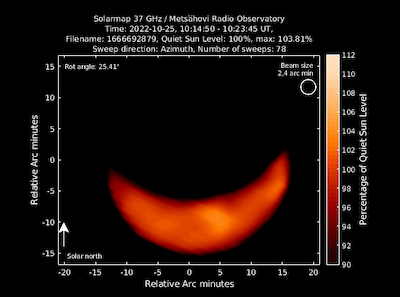
Solar eclipse with a radio telescope
by Joni Tammi and Juha Kallunki (Metsähovi Radio Observatory, Finland)
Northern Europe had front-row seats for the partial solar eclipse in October 2022. Unfortunately, the sky was overcast in most of Finland, and in most heavily populated southern cost it was raining the whole day. What a day to have a radio telescope!
Aalto University Metsähovi Radio Observatory (MRO) in Kirkkonummi, southern Finland, has been monitoring the Sun at high radio frequencies since the late 1970s. The radome-enclosed 14-m radio telescope is used to create “radio maps” of the Sun by raster-scanning over the solar disk at 37 GHz frequency while recording the total flux density. The aim is to produce at least one solar radio map each day throughout the year. Solar observations are one of MRO’s three main observing modes, together with single-dish AGN monitoring and VLBI, and during the long northern summer days the Sun can be observed literally around the clock; during summer months Metsähovi gets some 18 hours of sunshine per day (not so much in winter though…). The beam size of the 14-m dish at 37 GHz is 2.4 arc minutes, and it takes about 2.5 minutes to complete one scan. During the eclipse, however, the maps take up to nine minutes due to the enlarged scanning area because we wanted to also get the Moon into the view both before and after the eclipse.

eclipse maximum (62%). Credit: Metsähovi Radio Observatory.
Solar eclipses provide a great opportunity for testing the equipment: as the sharp edge of the Moon’s disk occults various active regions and parts of the Sun, the observed effects at different frequency domains can be used to “enhance” the angular resolution due to relatively large beam size. From the astronomical point of view, this also enable detailed comparison between the sources of the radiation at different frequency bands. Although we semi-routinely carry out New Moon observations to offer a calibration target for the solar observations, having both the dark side of the Moon and the Sun in the same picture, even overlapping, is also a great demonstration of the sensitivity range of the system for the wider public. A more detailed description of the observations is in preparation by Kallunki et al.
During the October eclipse it was raining at Metsähovi (and most of Finland) during the whole eclipse, but we were still able to produce reasonably good images. While the rain clouds may have prevented obtaining technical and scientific results, they had silver lining: as none other observatory was able to produce news-worthy images of the eclipse, the media turned to radio astronomers.
Find details and animations of the partial solar eclipse as seen with radio telescopes here.